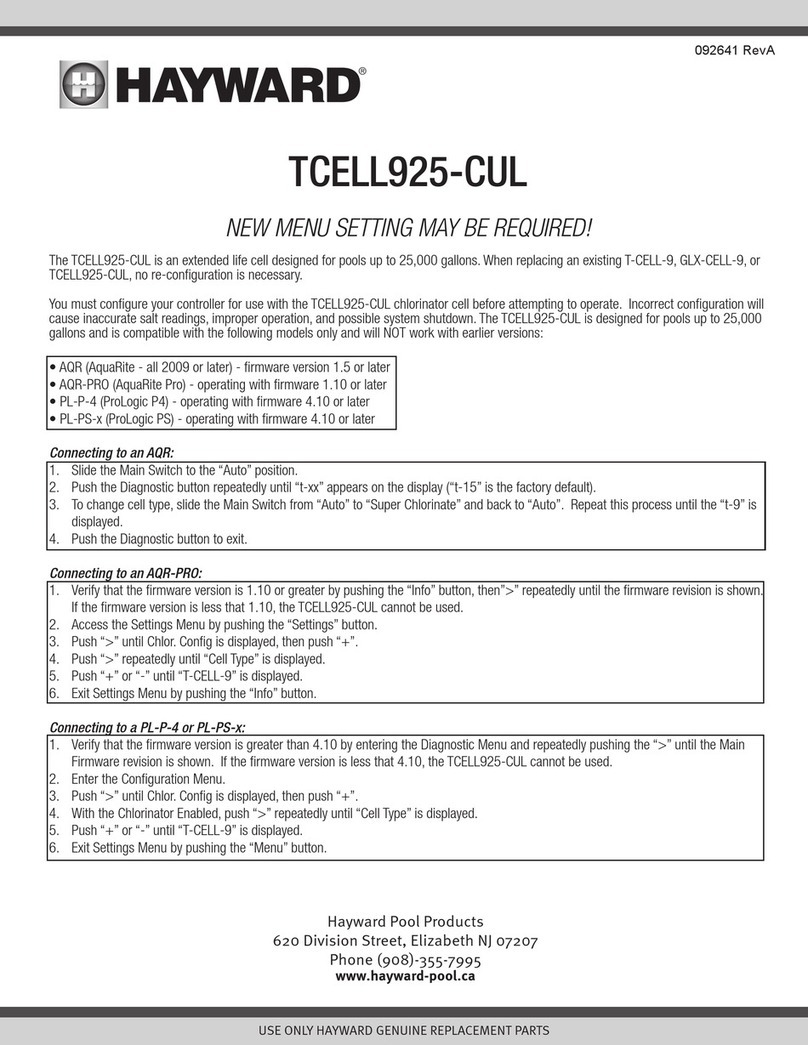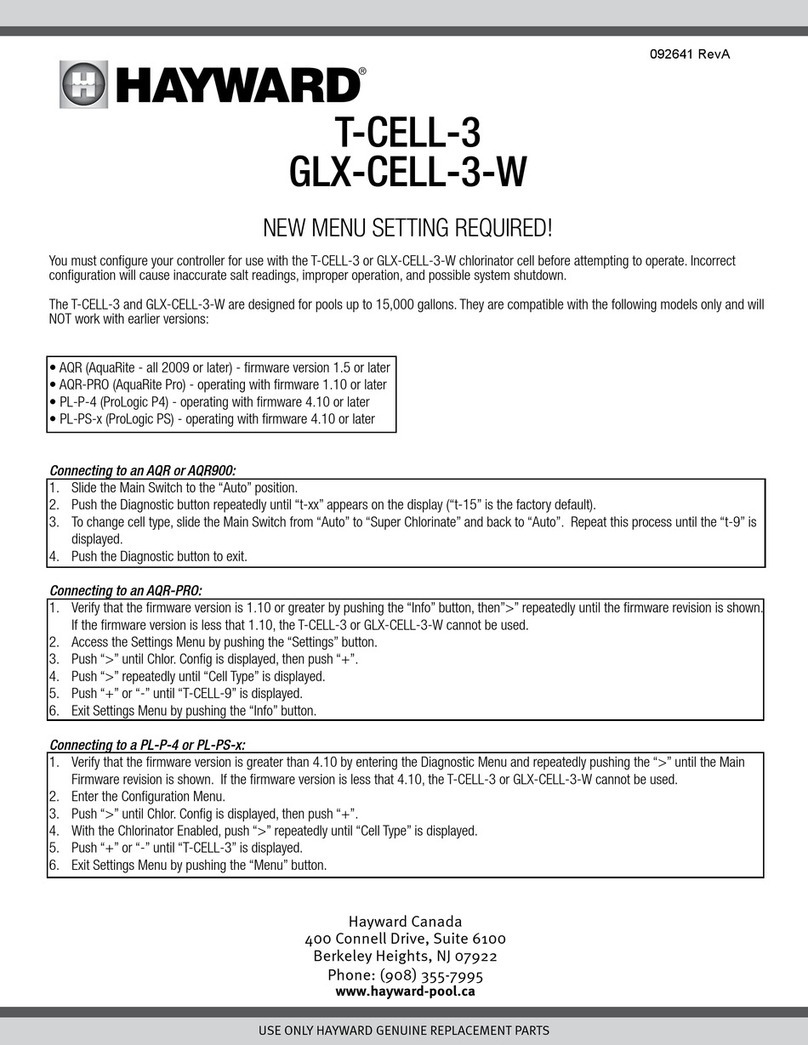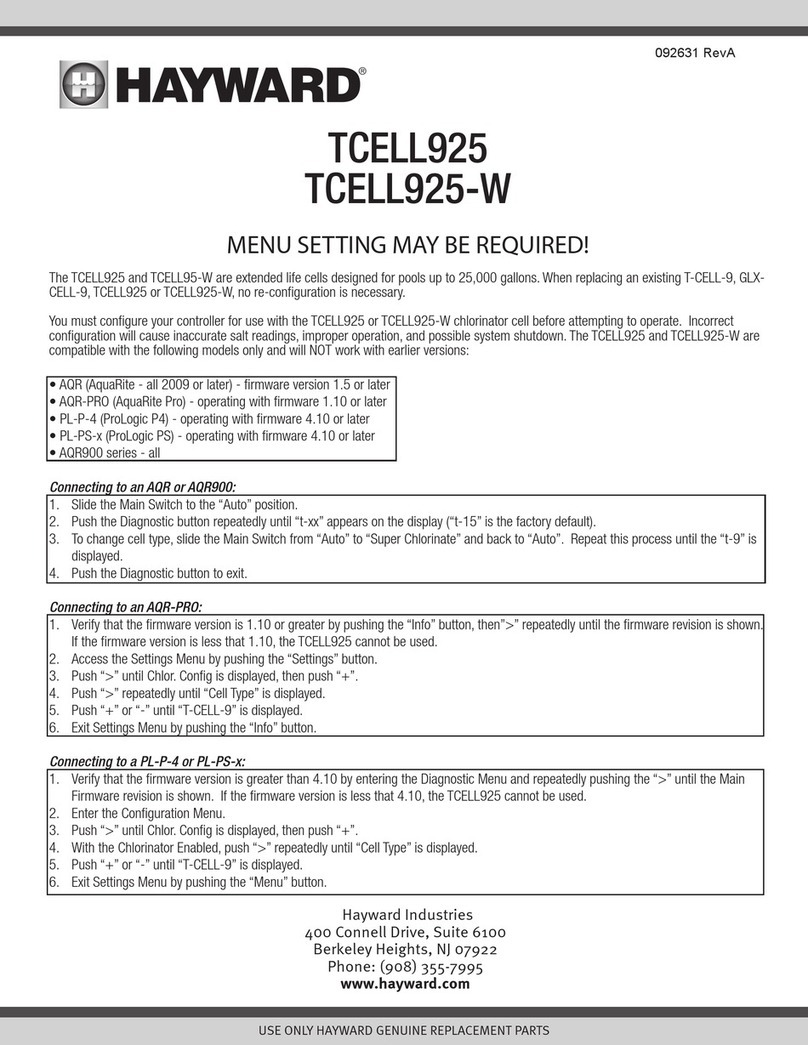Hayward TCELL940 User manual

USE ONLY HAYWARD GENUINE REPLACEMENT PARTS
092625 RevC
Hayward Industries
400 Connell Drive, Suite 6100
Berkeley Heights, NJ 07922
Phone: (908) 355-7995
www.hayward.com
TCELL940
TCELL940-W
MENU SETTING MAY BE REQUIRED!
The TCELL940 and TCELL940-W are cells designed for pools up to 40,000 gallons. When replacing an existing T-CELL-15, GLX-CELL-15,
or TCELL940, no re-configuration is necessary.
If configuration is required, refer to the information below. Incorrect configuration will cause inaccurate salt readings, improper operation,
and possible system shutdown.
CONFIGURATION is necessary with the following models:
• AQR (Aqua Rite - all 2009 or later) - firmware version 1.5 or later
• AQR-PRO (Aqua Rite Pro)
• OmniLogic & OmniPL - refer to owner’s manual for configuration
• PL-P-4 (Pro Logic P4)
• PL-PS-x (Pro Logic PS)
• AQ-LOGIC-P-4 (Pro Logic P4)
• AQ-LOGIC-PS-x (Pro Logic PS)
• AQR900 series - all
NO CONFIGURATION is necessary with the following models:
• AQ-RITE (Aqua Rite - 2008 and earlier) - firmware earlier than version 1.5
• AQ-RITE-XL (Aqua Rite XL)
Connecting to an AQR or AQR900:
1. Slide the Main Switch to the “Auto” position.
2. Push the Diagnostic button repeatedly until “t-xx” appears on the display (“t-15” is the factory default). If “t-15” is displayed, skip to
step 4.
3. To change cell type, slide the Main Switch from “Auto” to “Super Chlorinate” and back to “Auto”. Repeat this process until the “t-15” is
displayed.
4. Push the Diagnostic button to exit.
Connecting to an AQR-PRO:
1. Access the Settings Menu by pushing the “Settings” button.
2. Push “>” until Chlor. Config is displayed, then push “+”.
3. Push “>” repeatedly until “Cell Type” is displayed.
4. Push “+” or “-” until “T-CELL-15” is displayed.
5. Exit Settings Menu by pushing the “Info” button.
Connecting to an AQ-LOGIC-P-4, AQ-LOGIC-PS-x, PL-P-4 or PL-PS-x:
1. Enter the Configuration Menu.
2. Push “>” until Chlor. Config is displayed, then push “+”.
3. With the Chlorinator Enabled, push “>” repeatedly until “Cell Type” is displayed.
4. Push “+” or “-” until “T-CELL-15” is displayed.
5. Exit Settings Menu by pushing the “Menu” button.

USE ONLY HAYWARD GENUINE REPLACEMENT PARTS
IMPORTANT INFORMATION
Regarding Extended Pool Filtration cycles, and Low Flow Rate conditions
THE AMOUNT OF CHLORINE PRODUCED BY YOUR SALT CHLORINE GENERATING SYSTEM IS DEPENDENT ON THE LENGTH OF TIME THAT YOUR FILTER
PUMP RUNS EVERY DAY. SO, YOUR CHLORINATION SETTING SHOULD BE MATCHED TO THE FILTER PUMP RUN TIME OF YOUR POOL.
Whether you plan to INCREASE or DECREASE the filter pump cycle on your pool, adjust the chlorination setting using the dial on your AquaRite chlorina-
tor or the up and down keys on your AquaRite Pro or ProLogic controller. By properly adjusting your setting, you are preventing the over-chlorination
or under-chlorination of your pool.
For example, If you plan on doubling the filter pump operating time (say from 8 hours/day to 16 hours/day), then reduce your chlorination setting by a
factor of 2 (say from 50% to 25%). If you plan to triple your filter pump operating time, then reduce your chlorination setting by a factor of 3. Likewise,
if you reduce your filter pump operating time (say from 12 hours/day to 8 hours/day), then increase your chlorination setting by a factor of 1.5 (i.e.
12/8=1.5)
These adjustments, while necessary and important, are APPROXIMATIONS to the actual adjustment your pool requires. After any chlorination adjust-
ment, monitor the pool’s chlorine level closely for 1-2 weeks. If the readings stabilize in the 1-3 ppm range then you are all set—otherwise make
another small adjustment (up or down) to increase or decrease the chlorine level. Once the chlorinator is set, it is good practice to check your chlorine
levels weekly to ensure operation is normal.
WHEN USING 2 SPEED OR VARIABLE SPEED PUMPS ON LOW SPEED, CHECK TO BE SURE YOUR SALT CELL IS RECEIVING ADEQUATE FLOW. Low flow
conditions can result in insufficient water in the cell causing inefficient chlorine production. As a precaution, the cell can be installed vertically or in an
inverted manner (see illustration) to keep it flooded with water.
Vertical Installation Inverted Installation
Desired installation configurations when using 2 speed or variable speed pumps.

USE ONLY HAYWARD GENUINE REPLACEMENT PARTS
Hayward Pool Products
2880 Plymouth Drive, Oakville, ON L6H 5R4
Phone (888) 238-7665
www.hayward-pool.ca
TCELL940 & TCELL940-W
DE NOUVEAUX RÉGLAGES PEUVENT ÊTRE NÉCESSAIRES!
Les TCELL940 et TCELL940-W sont des cellules à conçues pour les piscines d’un volume maximum de 151 416 L (40 000 gal). Lorsque
vous remplacez une cellule existante de type T-CELL-15, GLX-CELL-15 ou TCELL940-CUL, une reconfiguration n’est pas nécessaire.
Toutefois, si une configuration est nécessaire, consultez les informations ci-dessous. Une configuration incorrecte se traduira par des lec-
tures de la teneur en sel inexactes, un fonctionnement inadéquat et peut-être même par l’arrêt du système.
UNE CONFIGURATION est nécessaire dans le cas des modèles suivants :
• AQR (Aqua Rite – tous les modèles 2009 et plus récents) – micrologiciel version 1.5 ou une version plus récente
• AQR-PRO (Aqua Rite Pro)
• PL-P-4 (Pro Logic P4)
• PL-PS-x (Pro Logic PS)
• OmniLogic & OmniPL - se référer au manuel du propriétaire pour la configuration
• AQ-LOGIC-P-4 (Pro Logic P4)
• AQ-LOGIC-PS-x (Pro Logic PS)
• AQR900 - tout
AUCUNE CONFIGURATION n’est nécessaire dans le cas des modèles suivants :
• AQ-RITE (Aqua Rite – modèles 2008 ou avant) – micrologiciel version antérieure à 1.5
• AQ-RITE-XL (Aqua Rite XL)
Raccordement à un AQR ou AQR900 :
1. Placez l’interrupteur principal en position « Auto ».
2. Appuyez sur la touche « Diagnostic » de façon répétitive jusqu’à ce que vous voyez « t-xx » à l’écran (« t-15 » est le réglage par défaut).
Si « t-15 » est affiché, passez à l’étape 4.
3. Pour changer le type de cellule, déplacez l’interrupteur principal de « Auto » à « Super Chlorinate » et de nouveau à « Auto ». Répétez ce
processus jusqu’à ce que « t-15 » s’affiche à l’écran.
4. Appuyez sur la touche « Diagnostic » pour quitter ce menu.
Raccordement à un AQR-PRO :
1. Accédez au menu des réglages en appuyant sur la touche « Settings ».
2. Appuyez sur « > » jusqu’à ce que Chlor. Config. s’affiche à l’écran; appuyez ensuite sur « + ».
3. Appuyez sur « > » de façon répétitive jusqu’à ce que « Cell Type » s’affiche.
4. Appuyez sur « + » ou « - » jusqu’à ce que « T-CELL-15 » s’affiche.
5. Quittez le menu des réglages en appuyant sur la touche « Info ».
Raccordement à un AQ-LOGIC-P-4, AQ-LOGIC-PS-x, PL-P-4 ou PL-PS-x :
1. Entrez dans le menu Configuration.
2. Appuyez sur « > » jusqu’à ce que « Chlor. Config. » s’affiche à l’écran; appuyez ensuite sur « + ».
3. Alors que le chlorateur est activé, appuyez sur « > » de façon répétitive jusqu’à ce que « Cell Type » s’affiche.
4. Appuyez sur « + » ou « - » jusqu’à ce que « T-CELL-15 » s’affiche.
5. Quittez le menu des réglages en appuyant sur la touche « Menu ».

USE ONLY HAYWARD GENUINE REPLACEMENT PARTS
Hayward is a registered trademark and AquaRite, ProLogic and OmniLogic
are trademarks of Hayward Industries, Inc. © 2022 Hayward Industries, Inc.
All other trademarks not owned by Hayward are the property of their respective owners.
Hayward is not in any way affiliated with or endorsed by those third parties.
RENSEIGNEMENTS IMPORTANTS
À l’égard des cycles de filtration prolongés et des conditions de faible débit
LA QUANTITÉ DE CHLORE PRODUIT PAR VOTRE SYSTÈME DE CHLORATION AU SEL SWIMPURE PLUS DÉPEND DU TEMPS DE FONCTIONNEMENT
QUOTIDIEN DE VOTRE POMPE DE FILTRE. LES RÉGLAGES DE VOTRE SYSTÈME DE CHLORATION DOIVENT DONC ÊTRE RÉGLÉS EN FONCTION DU
TEMPS DE FONCTIONNEMENT DE VOTRE POMPE DE FILTRE.
Que vous envisagiez d’AUGMENTER OU de DIMINUER la durée du cycle de fonctionnement de la pompe de filtre de votre piscine, vous devez ajuster le
réglage de votre système de chloration. Dans le cas du système de chloration AquaRite, utilisez le cadran, tandis que dans le cas du système de com-
mande ProLogic, utilisez les flèches. En ajustant adéquatement vos réglages, vous éviterez de trop ou de ne pas assez chlorer l’eau de votre piscine.
Par exemple, si vous envisagez de doubler le temps de fonctionnement de la pompe de filtre de votre piscine (disons de 8 h/jour à 16 h/jour), réduisez
le réglage de chloration par un facteur de 2 (disons de 50 % à 25 %). Si vous envisagez de tripler le temps de fonctionnement de la pompe de filtre,
réduisez le réglage de chloration par un facteur de 3. De même, si vous réduisez le temps de fonctionnement de la pompe du filtre (disons de 12 h/
jour à 8 h/jour), augmentez le réglage de chloration par un facteur de 1,5 (c.-à-d. 12/8 = 1,5).
Ces ajustements, bien que nécessaires et importants, sont des APPROXIMATIONS des ajustements réels que requiert votre piscine. Après tout ajuste-
ment de chloration, surveillez attentivement la teneur en chlore de l’eau de votre piscine durant 1 à 2 semaines. Si les lectures se stabilisent entre 1
et 3 ppm, aucun autre ajustement n’est nécessaire. Toutefois, si ce n’est pas le cas, effectuez un autre petit ajustement (à la hausse ou à la baisse)
pour augmenter ou diminuer la teneur en chlore. Une fois la teneur en chlore stabilisée entre 1 et 3 ppm, il est judicieux de la vérifier chaque semaine
pour assurer un fonctionnement optimal.
LORSQUE VOUS UTILISEZ UNE POMPE À 2 VITESSES OU À VITESSE VARIABLE, ASSUREZ-VOUS QUE LE DÉBIT DANS LA CELLULE ÉLECTROLYTIQUE
EST ADÉQUAT. Des conditions où le débit est trop faible peuvent faire en sorte que la cellule reçoive une quantité insuffisante d’eau rendant ainsi la
production de chlore inefficace. Par précaution, la cellule peut être installée de façon verticale ou de façon inversée (consultez l’illustration ci-dessous)
afin qu’elle soit toujours pleine d’eau.
This manual suits for next models
1
Table of contents
Languages:
Other Hayward Cleaning Equipment manuals
Popular Cleaning Equipment manuals by other brands

Suevia
Suevia 130.5011 EASYCLEANER Mounting instructions

i-MO
i-MO Öko 2000 user guide

unGer
unGer Hydro Power Ultra UNP01 operating instructions

Black & Decker
Black & Decker BHPC130 Original instructions

Uni-ram
Uni-ram UG5000E operating manual

Axi
Axi MTC HC-300 Installation, operating and maintenance manual














